Ringworm of the feet is one of the most common diseases caused by parasitic fungi. In medical practice, there are several types of this pathology. It is important to identify the foot fungus early in its development. Then it will be quicker and easier to get rid of it. In this case, you will not need any special treatment and, even more, surgical intervention. With weak manifestations of fungal activity, it is enough to use antifungal ointments or baths from folkloric recipes.
Fungus and its varieties
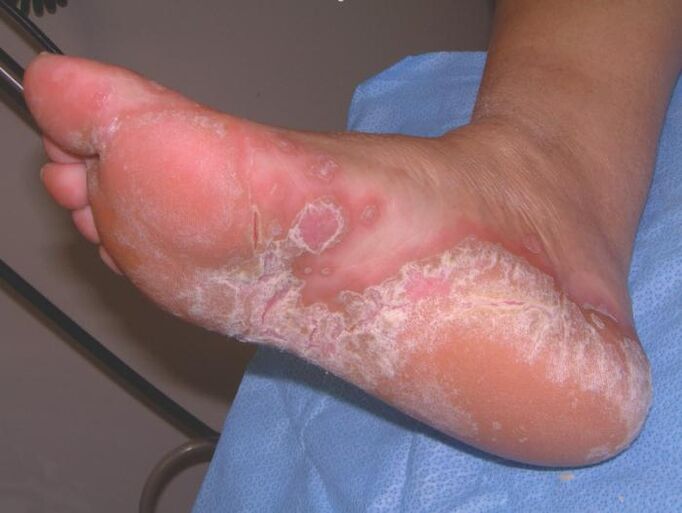
Despite the prevalence of foot fungus, not all infected people know what foot fungus looks like.
Below are the main types of mycoses:
- Flaky or scaly.
- Intertriginous. It is characterized by the type of skin intertrigo.
- Hypertrophic, atrophic and normotrophic onychomycosis. The difficulty in treating these diseases lies in the fact that all varieties can be combined with each other.
- Dyshidrotic. It is marked by a violation of the work of the sweat glands.
At different stages of development, this pathology looks different. Ringworm of the feet is the common name for two diseases: epidermophytosis and rubromycosis, whose development process occurs in the same way.
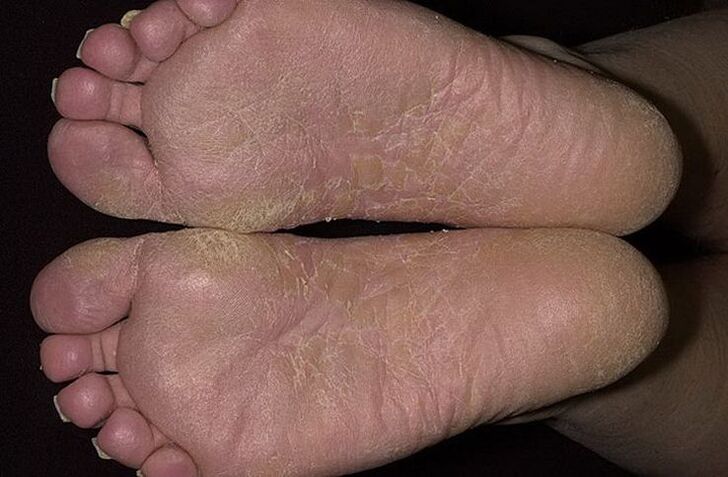
scaly ringworm
In the initial stage, the fungus manifests itself with the defeat of one foot, and after a while the disease passes to the other.
The skin turns red and then peels off. The area of the reddening areas in all patients is different and depends on the stage of development. Many people are not even bothered by itching in the affected area, the skin may not peel. Therefore, they only seek a dermatologist when their legs are affected by the last stage of the disease.
Dyshidrotic fungal infection
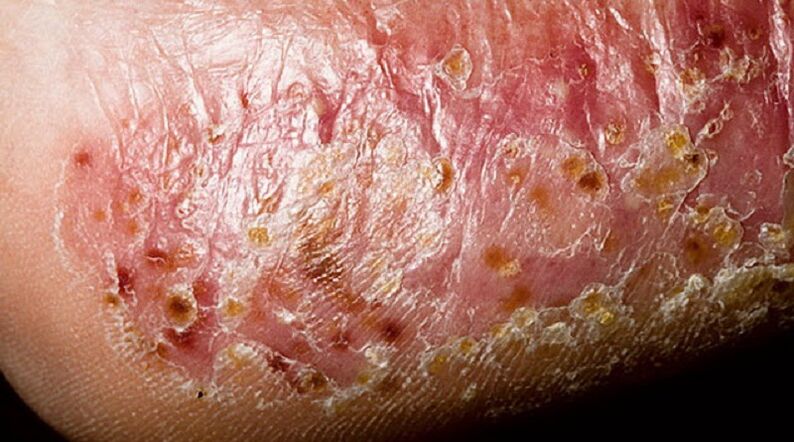
Anyone who suspects the onset of this disease should know what a foot fungus with any form of development looks like. This pathology is characterized by the appearance of miniature vesicles in the arch of the foot. Very little time passes, and they unite, transforming into large blisters, the shell of which soon breaks and the superficial lesion on the skin becomes visually noticeable.
The pathology can spread throughout the leg with the appearance of rash areas. In this case, the patient starts to scratch, painful sensations appear. After everything is cured, peeling begins.
The most unpleasant disease is the formation of a bacterial fungus. In this case, a cloudy liquid and pus come out of the bubbles that explode. At this stage in the development of the pathology, there is a slight increase in temperature and unbearable pain. The skin on the feet is swollen.
The process of the dyshidrotic form of ringworm can take several months. Periods of improvement in foot conditions alternate with relapses.
Intertriginous fungus
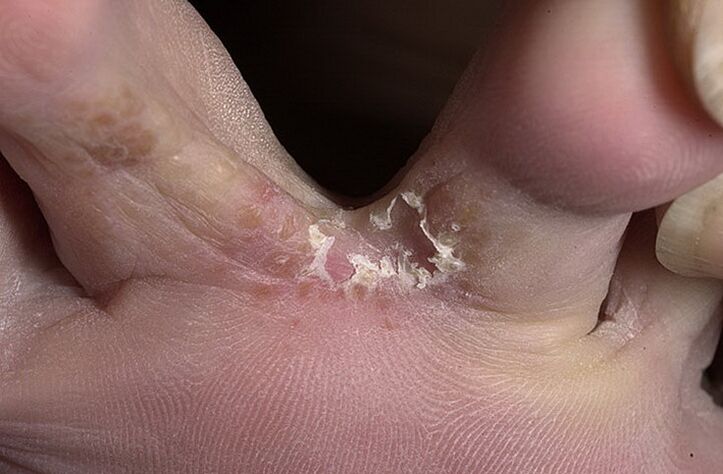
This type of fungus on the skin of the feet is the most common. Appears independently or together with the squamous form of pathology. The disease is manifested by cracks in the skin around which a white border forms and then the skin begins to flake off. The space between the fingers becomes wet. The patient feels itchy and burning. Superficial skin defects appear, accompanied by intense pain.
The skin's protective functions are reduced and it becomes loose. This promotes penetration of the streptococcal infection into the skin. A purulent inflammation appears, characterized by redness, itching, swelling, and severe pain.
Intertriginous fungus is most often characterized by a long chronic course of the disease process. In winter, the pain usually subsides, and in summer it becomes worse again.
Onychomycosis or nail fungus
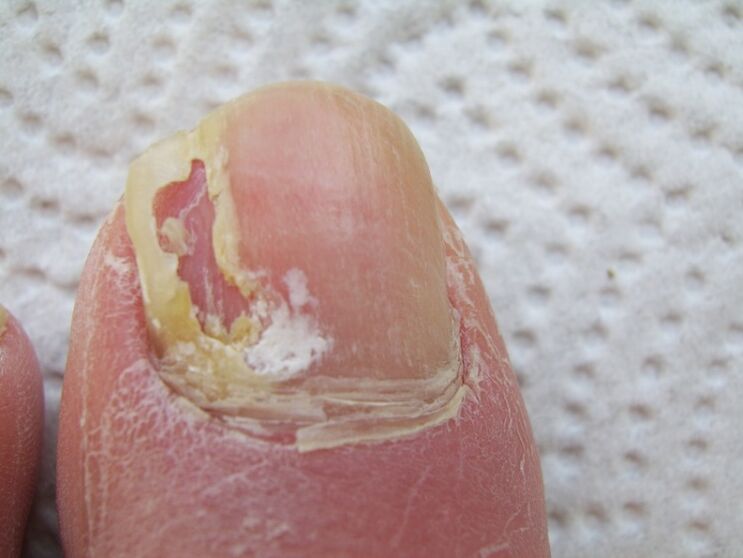
When the first signs of the disease appear, the patient's task is to contact the dermatologist in a timely manner, who will determine how to remove the fungus from the legs.
Nail onychomycosis is a more dangerous disease than fungal foot infection as it takes much longer to heal.
Varieties of fungal infection that affect the nail plate:
- Atrophic onychomycosis. First, the nail becomes thinner, then it falls apart.
- Hypertrophic onychomycosis. The thickness of the nail increases, acquiring a yellow color. The growth in length stops. The nail plate begins to unravel and exfoliate.
- Onychomycosis caused by fungi. This pathology does not develop alone. It usually progresses in the context of other illnesses. In this case, the nail plate can be painted in any color from black to green. The nail roller is usually inflamed.
In its neglected form, the disease affects the entire body and even penetrates the internal organs. Pathological changes usually begin to develop from the edge of the nail plate. Stripes, spots and other "patterns" appear first.
treatment methods

Not every patient knows how to remove foot fungus, but dermatologists do. Treatment primarily involves blocking the development of a fungal infection. To prevent re-infection of the feet by fungi, a complex treatment is used:
- External therapy course. Antifungal ointments, creams and sprays are used in the treatment.
- The course of treatment using antimycotic drugs.
- Use of antihistamines. They are administered in case of severe itching and hypersensitivity to irritants that cause allergies.
- The course of therapy with the intake of vitamins and minerals.
- Antibacterial drugs. They are used in case of bacterial infection of the body.
When visiting a doctor, a person will find out how to treat fungus on the nails, heels and the space between the toes. With an advanced form of the disease, the doctor usually prescribes a complex treatment with the ingestion of pills and the use of ointments. Systemic drugs are prescribed for those patients who have already started a severe course of the process.
For the treatment of a fungal infection in the legs at home, the following popular recipes are used:
- Vinegar. Due to its antiseptic properties, wine vinegar is used for bathing.
- Salt and soda. They dissolve in water in equal amounts and take baths that help remove the fungus from your feet.
- Oak bark, marigold inflorescences, blackberries. Wash the affected areas of the feet with a decoction of these medicinal herbs.
The most effective is the complex treatment of the fungus with the use of ointments and drugs with different pharmacological actions. Treatment will never be necessary if you listen to your doctors' recommendations and periodically take preventive measures.
antifungal drugs
The fungus from the feet and the interdigital space is removed with effective fungicidal drugs.
As the fungus can manifest itself in any form, a specialist must select an effective remedy to fight this infection. Some medications are toxic and can cause side reactions and are taken under the strict supervision of a doctor. A quick positive result of the treatment depends on the correct diagnosis not only of the disease, but also of the stage of its development.















